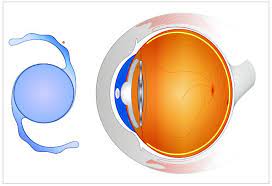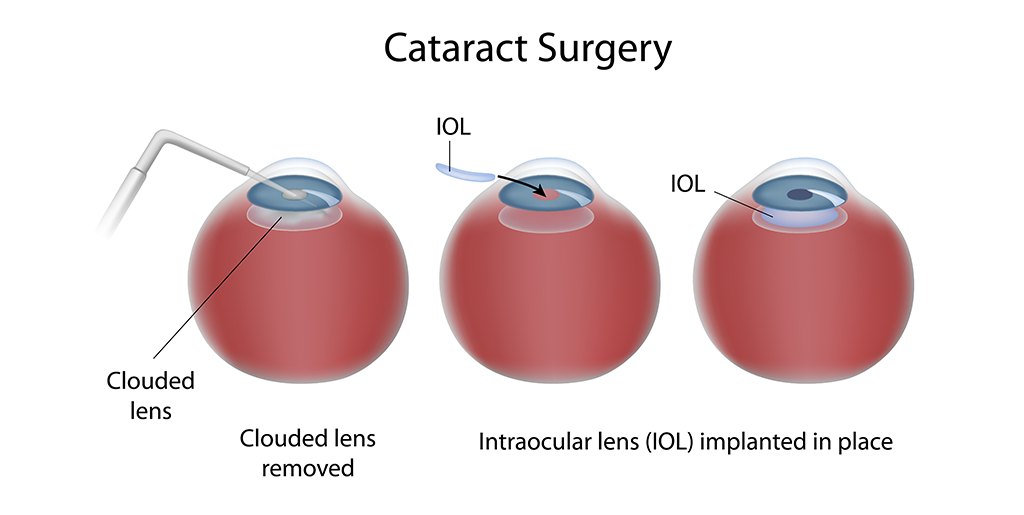If you have been told by your ophthalmologist that you have cataracts and need surgery to remove them. Intraocular lenses have only been approved in the USA as “safe and effective” by the Food and Drug Administration (USFDA) since 1981. From then until now, the different styles of lenses that are implanted for cataract treatment have been nothing short of a revolution. Then you will also need to choose a lens implant during your surgery. There are many different types of implants available, and it can be confusing to know which one is right for you. In this blog post, we will discuss the most common types of Cataract Lenses IOL implants and how to choose the right one for you.
Contents
Different Types Of Cataract Lenses IOL

When it comes to treating cataracts, the intraocular lens (IOL) plays a major role. An IOL is an artificial lens that is implanted during a surgical procedure to replace any cloudy or hardening natural lenses of the eye.
After your natural lens becomes opaque due to cataract removal, an intraocular lens (IOL) is implanted in the eye, to restore your vision. The first IOL that was ever implanted in human eyes was made of acrylic called Perspex and manufactured in 1949 by Sir Harold Ridley. With advancements in available IOL technology over the years, a new kind was introduced.
There are nine types of IOLs available today:
Monofocal Lenses
Monofocal lenses are the most commonly used IOLs for cataract surgery. These lenses have a single focus point, so they correct vision at one distance — usually far away. While monofocal lenses can help improve your vision after cataracts, you may need to wear glasses or contact lenses to be able to see clearly at different distances.
The various types of Monofocal lenses are:
Aurium(Monofocal)
Aurium monofocal lenses are manufactured by Medennium (USA) and are equipped with photochromatic technology. These lenses become transparent under normal lighting conditions but will become lightly tinted during daytime or bright light to prevent wear on the retina from harmful UV rays.
Acrysof IQ(Monofocal)
Acrysof IQ monofocal lenses are manufactured by Alcon (USA) and provide excellent vision for distance. For near vision, however, these lenses require an extra pair of reading glasses. This lens contains a yellow pigment chromatophore that blocks harmful UV rays from entering the eye and damaging the retina.
Aurovue(Monofocal)
Aurovue monofocal lenses are manufactured by Aurolab in India, an entry-level option for cataract surgery for those on a low budget.
Akreos AO(Monofocal): Akreos AO is a Bausch & Lomb (USA) product and they’re similar to Aurovision except they’re imported instead of domestic.
Multifocal Lenses
These IOLs have multiple focus points and can allow you to see clearly at both near and far distances without the need for glasses or contact lenses. Depending on the lens chosen, it is possible that patients may still need to use glasses if they want to read very small print or see in low-light conditions.
The following are the best multifocal lenses:
The Tecnis Symphony (Multifocal)
It is a multifocal lens. This lens provides excellent distance and intermediate vision (computer working).
Zeiss Trifocal (Multifocal)
It is a multifocal type lens. These lenses provide excellent vision for near, intermediate, and distance.
iDiff (Multifocal)
They are multifocal lenses. These lenses provide good vision for near and distance, which means that a person can easily carry out regular day-to-day activities with distance vision and also do near work such as reading and writing comfortably without the use of additional spectacles. iDiff Lenses, however, do not correct intermediate vision.
Tridiff (Multifocal)
They are multifocal type lenses. These lenses provide good vision for distance and intermediate so that the person can thus carry out regular day-to-day tasks with the help of distance 3D vision, at the same time do intermediate tasks such as notebook work or other computer work comfortably without using extra spectacles. They however do not have an appropriate correction for near-sightedness
Toric Lenses
A toric lens is designed to correct astigmatism, which is an eye condition that causes blurred or distorted vision due to a cornea shape that is irregularly curved. With a toric IOL, patients can achieve improved vision without the need for glasses or contact lenses. Glasses, contacts and Toric Lenses are all corrective devices that can be used to correct the power of an eye. Monofocal and Multifocal lenses only correct for spherical power leaving behind any remaining cylinder or astigmatism. On the other hand, Toric lenses provide for both spherical and auxiliary power in one lens. We recommend Toric lenses if you have a high pre-existing level of cylinder or astigmatism.
Extended Depth-of-Focus Lenses (EDOF)
EDOF lenses are designed to improve vision at all distances. Unlike multifocal lenses, these IOLs do not have multiple points of focus; instead, they provide a continuous range of vision from near to far without the need for glasses or contact lenses.
Trifocal Lenses
These lenses are similar to multifocal lenses, but with three distinct areas of focus as opposed to two. This makes them better suited for individuals who need a more precise range of vision than that provided by multifocal lenses.
Symfony Lenses
Symfony lenses are designed to provide a continuous range of vision, similar to EDOF lenses, but with fewer side effects and greater contrast sensitivity compared to other IOLs.
Presbyopic Correcting
When it comes to choosing a cataract lens, there are seven types of Intraocular Lenses (IOLs) that can be used. These include single-focus IOLs, multifocal IOLs, and accommodating lenses. It’s important to understand the differences between each type of lens before making a decision as to which one is best for you.
Single-Focus IOLs
Single-focus lenses are designed to provide clear distance vision without the need for glasses or contacts. This lens works well for those who would like to see distant objects clearly, such as faraway billboards or television screens. However, if you do a lot of close-up work, reading, or computer use, you may need to have glasses for near vision.
Accommodating Lenses
Accommodating lenses are designed to move back and forth within the eye for focusing on different distances. This lens works well for those who have difficulty with both distance and near vision
Choosing the right IOL for cataract surgery can be a difficult decision. Your ophthalmologist will discuss with you all your options and help you decide which one is best suited to your lifestyle and needs. This can depend on factors such as your age, overall health, near vision requirements, and any existing eye.
Types of intraocular lenses (IOLs)
The two most common types of lenses are:
Anterior Chamber Lenses (ACIOL)
These lenses are placed over the front iris and not the physiological position of the natural lens. ACIOLs are implanted in cases when there is a deficiency or damage to the posterior capsule behind the iris.
Posterior Chamber Lenses (PCIOL)
These lenses are tucked into place at the rear. They are in the bag position, which is their natural body position. PCIOLs are usually preferred after uncomplicated cataract surgery, but occasionally an ACIOL will be used as well.
Microincision cataract surgery, Phacoemulsification, or Femtosecond laser cataract surgery is required for this type of IOL implantation.
Which is The Most Common IOL?
Monofocal IOL s are the most common type of lens used for cataract surgery. Monofocal lenses are designed to provide clear, crisp vision at a single distance and are typically used to improve distance vision. Although monofocal IOLs do not correct presbyopia or astigmatism, they can be modified with laser treatments or secondary surgeries if needed.
Which Types of Cataract Lenses IOL is Right For You?
Cataracts can have a major impact on your vision and overall quality of life. One of the most important things is understanding the options that are available to you. Your doctor will explain the pros and cons of each option, and you can decide which one is best for your lifestyle, visual needs, and your expectations from the cataract surgery.
They cause blurry or dimmed vision and increased sensitivity to bright lights. They may even lead to complete blindness if left untreated. Depending on the severity of your condition, it is important to choose the right cataract lens for your particular needs.
Intraocular lenses, or IOLs, are artificial lenses that are surgically inserted into the eye to replace the eye’s natural lens. After it has been removed during cataract-removal surgery. Monofocal IOLs provide excellent vision at one distance, usually far away. Multifocal IOLs are designed to provide good near and distant vision. Without the need for glasses or contact lenses in all lighting conditions. Accommodating IOLs use an internal focusing system to adjust focus depending on the lighting conditions. Trifocal IOLs offer a combination of near, intermediate, and distant vision. Toric IOLs are designed to correct astigmatism, while EDOF IOLs provide a continuous range of vision from near to far.
When choosing an intraocular lens for cataract surgery, it is important to consider your lifestyle and visual needs. Talk with your eye doctor about which option will be best for you.
Be sure to discuss the potential risks of each type of IOL, as well as the potential benefits. Depending on your needs and lifestyle, one type may be more suitable than another. Your eye doctor will help you make an informed decision about which cataract lens is right for you. With the right choice, your vision can be improved, and you can enjoy a clear vision once again.
Conclusion
It may be concluded that types of cataract lenses IOL can provide significant visual improvement for those suffering from cataracts. However, it is important to choose the right one for you based on your individual needs and lifestyle. A qualified ophthalmologist can help make sure that you get the ideal lens type to restore your vision.
Cataract surgery is a safe and painless procedure. At MantraCare we have a team of experienced eye surgeons, who will be happy to answer any questions on cataract surgery. Call us at +91-9711116605 for any inquiries.
